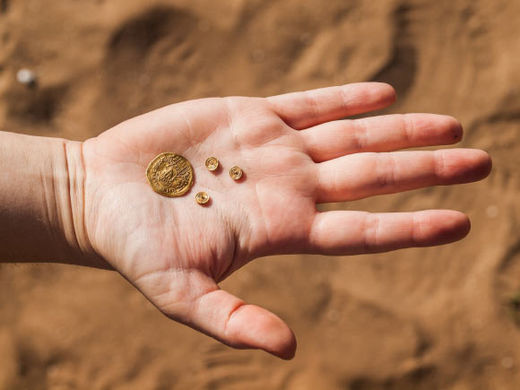
Located near the ancient city of Apollonia-Arsuf, the Byzantine refuse pit is one of many unearthed in the area. But unlike the other garbage dumps, the pit measures more than 100 feet in diameter.
As they dug into it, the archaeologists found a hoard of 400 Byzantine coins, 200 intact Samaritan lamps and gold jewelry amid animal bones, pottery and glass fragments.
Most objects date to the 5th-7th centuries A.D.
What was a 1,500-year-old treasure doing in a garbage pit remains a mystery, said archaeologists Oren Tal of Tel Aviv University and Moshe Ajami of the Israel Antiquities Authority.
"The large amount of usable artifacts in the pit raises questions. Noteworthy among the jewelry is an octagonal ring with parts of verses from the Samaritan Pentateuch engraved in Samaritan script," Tal and Ajami said.
One side reads: "Adonai is his name," the other side: "One God..."
Approximately a dozen discovered Samaritan rings have been recorded so far in scientific literature.
"This ring constitutes an important addition given the assemblage in which it was discovered," the archaeologists said.
The site once served as the agricultural hinterland of Apollonia-Arsuf, which is located west of the excavation area and what is today the Apollonia National Park.
Excavations conducted there from the 1950s until the present indicate that the site was inhabited continuously for more than 1,500 years - from the Persian period in late 6th century B.C. until the end of the Crusader period in the 13th century.
Populated by both Christians and Samaritans during the Byzantine period, Arsuf featured industrial quarters with wine presses, olive presses, plastered pools and kilns for the productin of raw glass.
The site was conquered by the Crusaders in 1101 and by the middle of the 12th century was turned over to the one of the aristocratic Crusader families, becoming the center of a feudal manor. In 1241 a fortress was built, and in 1261 control of the fortified city was handed over to a Christian military order called the Kinghts Hospitaller.
By the end of the Mamluk siege in 1265, Arsuf was destroyed.
"Since its defeat, the site has never been reoccupied," the archaeologists said.
In addition to the mysterious pit, Tal and Ajami unearthed the remains of wine and olive presses, as well as ruined walls that were apparently part of buildings meant to serve local farmers.



"Key" to the Shining City of Truth, Found . . .In garbage pit in Israel.
Of course, 'they' maintain they must return 'truth's key' to its Israeli burial place... for 'Architectural Integrity!"
"Yeah! That's the ticket!"
R.C.